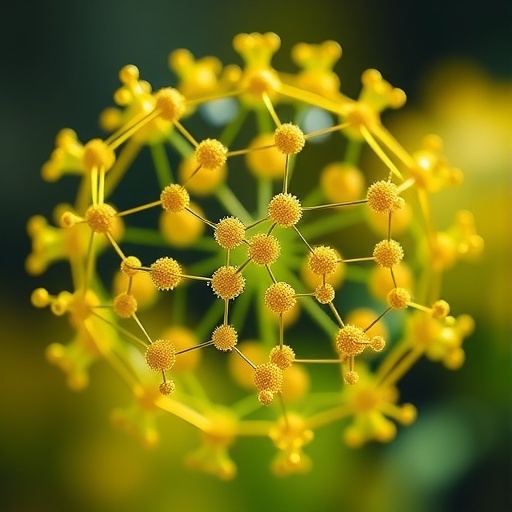In a groundbreaking advance merging biotechnology with nanomedicine, researchers from Osaka University in Japan have developed a novel, eco-friendly method to synthesize gold nanoparticles (AuNPs) utilizing microalgae. This green synthesis technique harnesses the natural biochemical properties of microalgal extracts to reduce gold ions into functionalized nanoparticles with enhanced photothermal stability, a significant leap forward for cancer therapeutics and sustainable nanomaterial production.
Gold nanoparticles have long been recognized for their unique optical and thermal properties, making them invaluable in medical applications such as photothermal therapy (PTT). This technique involves directing a laser at AuNPs concentrated within tumors. The nanoparticles absorb the light and convert it into localized heat, elevating the temperature enough to selectively ablate cancerous tissue without damaging nearby healthy cells. However, conventional chemical synthesis of AuNPs often employs toxic reagents, requires extensive energy input, and results in nanoparticles with variable stability and biocompatibility, limiting clinical potential.
The Osaka team’s discovery pivots on leveraging microalgal biomass as a biological “nanofactory.” The microalgae produce a complex matrix of biomolecules — including proteins, pigments, and antioxidants — which act as natural reducing and stabilizing agents. When exposed to chloroauric acid (HAuCl₄), these biomolecules facilitate the reduction of Au³⁺ ions to elemental gold, simultaneously capping and functionalizing the nanoparticles to prevent aggregation and enhance stability. This bio-mediated process, conducted under mild conditions, circumvents the need for hazardous chemicals or high temperatures characteristic of traditional methods.
Extensive characterization revealed that the bio-synthesized AuNPs (“Bio@AuNPs”) boast exceptional photothermal conversion efficiency and thermal stability. These nanoparticles exhibited a uniform spherical morphology with controlled size distribution, key factors for predictable in vivo behavior. Furthermore, in vitro assays demonstrated selective cytotoxicity toward cancer cells upon laser irradiation, while maintaining minimal toxicity to normal cells. This selective biocompatibility is attributed to the natural organic coating derived from algal biomolecules, which appears to mitigate unwanted interactions with healthy tissues and reduce oxidative stress.
Beyond therapeutic efficacy, the implications for sustainable manufacturing are profound. The microalgae-based synthesis drastically reduces environmental burdens: the process requires less energy, produces negligible chemical waste, and uses renewable biological materials. In the context of global efforts aligned with the United Nations Sustainable Development Goals (SDGs), this innovation represents an important step toward greener nanotechnology in healthcare.
The stability of these “Bio@AuNPs” under photothermal conditions is particularly noteworthy. Traditional AuNPs often suffer from degradation or morphological changes upon repeated laser exposure, leading to diminished treatment effectiveness and potential safety concerns. The algae-derived nanoparticles maintain their photothermal properties over extended periods, ensuring reliable performance during therapy sessions.
Professor Madoka Suzuki, lead investigator of the study, highlights that this work not only paves the way for safer cancer therapies but also offers a novel platform for exploring cellular thermoregulation. Understanding how living cells detect and respond to localized heat generated by such nanoparticles could unlock new insights in cell biology and aid in designing even more precise therapeutics.
Crucially, this work addresses persistent challenges in nanomedicine — toxicity, stability, and scalability — by integrating biological systems with nanomaterial science. The use of living organisms to fabricate high-value nanoparticles introduces a level of functional complexity and biocompatibility that synthetic chemistry struggles to achieve alone.
The study included rigorous experimental validation, comparing the biological synthesis technique against traditional chemical methods. It confirmed that the Bio@AuNPs’ functionalization by microalgal biomolecules leads to enhanced stability in physiological conditions and impressive photothermal responsiveness. Such attributes make these nanoparticles ideal candidates for clinical translation in photothermal cancer therapy and potentially other modalities requiring localized heat generation.
In addition to therapeutic applications, functionalized AuNPs synthesized via green methods may find utility in diagnostic imaging, drug delivery, and biosensing. Their natural coatings facilitate further surface modification for targeted delivery or multimodal treatment strategies, broadening their impact beyond photothermal therapy.
The transformational potential of microalgae-mediated nanoparticle synthesis extends well beyond the laboratory. By establishing a sustainable, scalable route that aligns with environmental imperatives, this approach could redefine the future landscape of nanoparticle fabrication in medicine, reducing costs and environmental impact while enhancing patient safety.
This pioneering research demonstrates how interdisciplinary collaboration across bioengineering, materials science, and environmental chemistry can produce innovations that resonate with global health and ecological priorities. As the demand for precision nanomedicine grows, sustainable synthesis strategies like this will be critical to delivering safe, effective therapies worldwide.
The article detailing these findings, titled “Microalgae-Mediated Synthesis of Functionalized Gold Nanoparticles with High Photothermal Stability,” appeared in the peer-reviewed journal ACS Sustainable Chemistry & Engineering. This work is supported by prominent Japanese research institutions, including the Japan Society for the Promotion of Science and the Takeda Science Foundation, underscoring the importance of sustained investment in green nanotechnology.
Subject of Research: Not applicable
Article Title: Microalgae-Mediated Synthesis of Functionalized Gold Nanoparticles with High Photothermal Stability
News Publication Date: 7-Nov-2025
Web References: http://dx.doi.org/10.1021/acssuschemeng.5c07786
References: DOI: 10.1021/acssuschemeng.5c07786
Image Credits: Reham Samir Hamida and Madoka Suzuki
Keywords: Medical technology, Nanomedicine, Green chemistry, Cancer research, Gold nanoparticles, Reactive oxygen species, Surface modification, Microalgae




